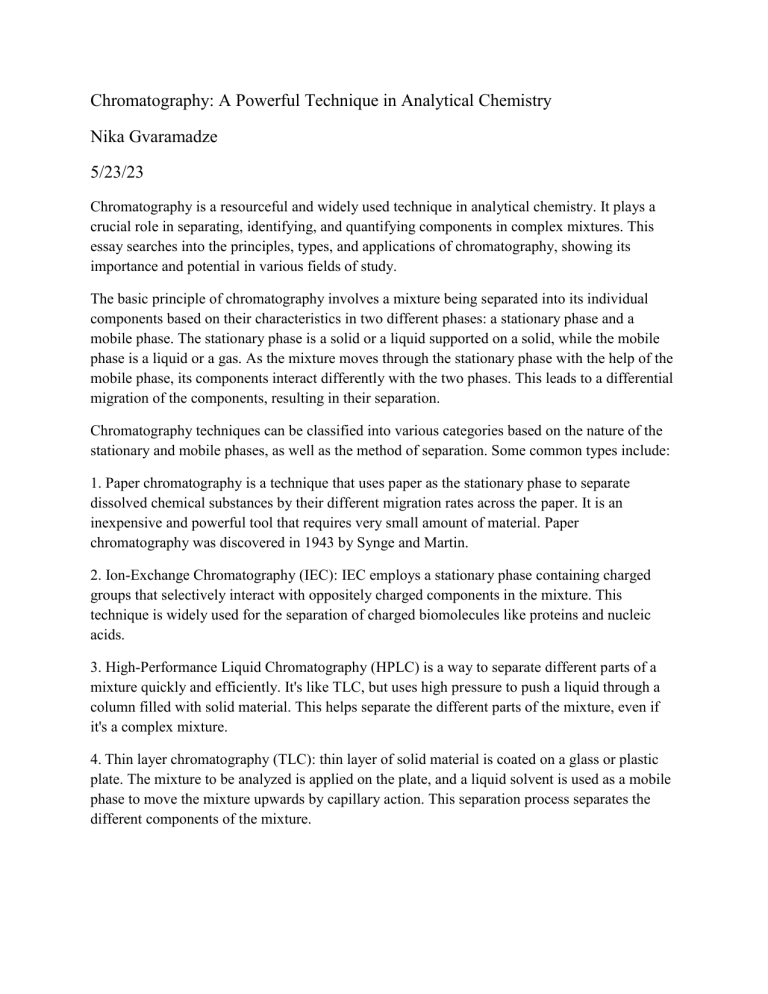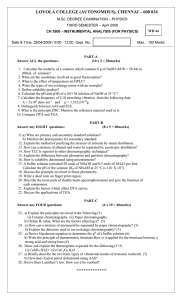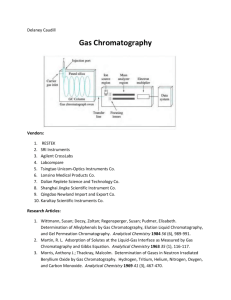Chromatography: Principles, Types & Applications in Analytical Chemistry
advertisement

Chromatography: A Powerful Technique in Analytical Chemistry Nika Gvaramadze 5/23/23 Chromatography is a resourceful and widely used technique in analytical chemistry. It plays a crucial role in separating, identifying, and quantifying components in complex mixtures. This essay searches into the principles, types, and applications of chromatography, showing its importance and potential in various fields of study. The basic principle of chromatography involves a mixture being separated into its individual components based on their characteristics in two different phases: a stationary phase and a mobile phase. The stationary phase is a solid or a liquid supported on a solid, while the mobile phase is a liquid or a gas. As the mixture moves through the stationary phase with the help of the mobile phase, its components interact differently with the two phases. This leads to a differential migration of the components, resulting in their separation. Chromatography techniques can be classified into various categories based on the nature of the stationary and mobile phases, as well as the method of separation. Some common types include: 1. Paper chromatography is a technique that uses paper as the stationary phase to separate dissolved chemical substances by their different migration rates across the paper. It is an inexpensive and powerful tool that requires very small amount of material. Paper chromatography was discovered in 1943 by Synge and Martin. 2. Ion-Exchange Chromatography (IEC): IEC employs a stationary phase containing charged groups that selectively interact with oppositely charged components in the mixture. This technique is widely used for the separation of charged biomolecules like proteins and nucleic acids. 3. High-Performance Liquid Chromatography (HPLC) is a way to separate different parts of a mixture quickly and efficiently. It's like TLC, but uses high pressure to push a liquid through a column filled with solid material. This helps separate the different parts of the mixture, even if it's a complex mixture. 4. Thin layer chromatography (TLC): thin layer of solid material is coated on a glass or plastic plate. The mixture to be analyzed is applied on the plate, and a liquid solvent is used as a mobile phase to move the mixture upwards by capillary action. This separation process separates the different components of the mixture. 5. Gas chromatography (GC): separates different substances in a mixture. It uses a thin layer of liquid or solid inside a long, thin tube called a capillary column. An inert gas such as helium or nitrogen is used to move the mixture through the column. The sample is turned into a gas and carried through the column by the gas, which separates its different components. Chromatography has numerous applications across various fields, such as: 1. Pharmaceutical Industry: Chromatography is extensively used in the pharmaceutical industry for the analysis and quality control of drug products, as well as the identification and purification of natural and synthetic compounds. 2. Environmental Analysis: Chromatographic techniques are used to monitor and quantify pollutants in air, water, and soil samples, helping the assessment of environmental quality and the development of remediation strategies. 3. Food and Beverage Industry: Chromatography is used to analyze food constituents, additives, and contaminants, ensuring the safety and quality of food products. 4. Forensic Science: Chromatographic methods are employed in forensic analysis to detect and identify trace evidence, such as drugs, explosives, and other organic compounds in criminal investigations. 5. Biochemical Research: Chromatography is an irreplaceable tool in biochemical research for the separation, identification, and quantification of biomolecules like proteins, nucleic acids, and metabolites. In conclusion, chromatography is an essential technique in analytical chemistry due to its versatility, sensitivity, and reliability. Its wide range of applications across various industries and research fields highlights its importance and potential in addressing complex analytical problems. As advancements in chromatographic technology continue to emerge, the technique will undoubtedly remain a cornerstone of modern analytical chemistry. Bibliography https://gentechscientific.com/the-different-types-of-chromatography/ https://www.thermofisher.com/blog/ask-a-scientist/what-is-chromatography/ https://www.quora.com/Why-is-chromatography-used





